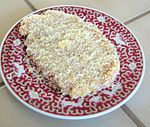Schnitzel
The schnitzel is usually prepared from a thin cutlet of veal although chicken or pork cutlets can be used instead of veal. Always cooked in butter or oil, the cutlet may or may not be sautéed as the cutlet may also be deep-fat fried. Variations of the schnitzel abound as this most famous recipe traveled throughout Europe.
Origin legends
The breaded schnitzel is a dish from Austria although variations of this dish are eaten throughout Europe including Germany and Italy. The recipe has a long history. Two frequently repeated legends claim to describe its origin:
- The first legend dates it back to the seventh century of the Byzantine empire. It says that "Kaiser"(sic!, Kaiser is German for emperor) Basileios (867–886 AD) liked eating his meat covered in gold, which eventually lead to cutlets being cooked in bread crumbs. The bread crumbs were substituted to represent the gold leaf-covered meat as a cost-saving measure.[1][2][3] The practice of preparing meat wrapped in bread crumbs spread throughout Europe.
The Etymology Meaning of Kaiser
Etymological sources indicate the term Kaiser was used by all Germanic and Slavic peoples in reference to all Roman emperors. "from Bavarian and Austrian spelling of M.H.G. keisar, from O.H.G. keisar "emperor," an early borrowing of L. cognomen Caesar (q.v.). The Germanic and Slavic peoples seem to have called all Roman emperors "caesar" (cf. O.E. casere, O.N. keisari). Said to be the earliest Latin loan word in Germanic."[4] [5]
- Another unproven story claims that the schnitzel was discovered in Italy by Austrian Joseph Graf Radetzky in the 1800s. The dish Radetzky discovered was known as costoletta alla milanese and was made from a thick slice of veal, coated in bread crumbs, then sautéed in butter. Radetzky, who served as commander of the Austrian troops from 1831 to 1857, shared the recipe with the emperor of Austria as part of his duties to report military, political and culinary affairs in Italy. After Radetzky had shared the costoletta alla milanese recipe, Austrian cooks perfected the recipe by pounding veal until it was a finger-width thick, dipped the cutlets in flour, egg and bread crumbs. The cutlets were cooked in hot fat until golden.[6][2]
Both stories could not be verified by historians.
Ingredients and preparation
Veal schnitzels are traditional but variations include cooking pork or chicken cutlets instead. The same technique is used as for veal.
Schnitzels may also be prepared minus the breading, when they are known as au naturel or au nature.[7][8]
The Wiener schnitzel originated from Vienna and is made from veal. This dish is often found at German restaurants too.[1][2]
Some ways to prepare schnitzels include cheese schnitzel where the veal cutlet is prepared as for Wiener schnitzel. The cutlet is dipped in a half and half mixture of Parmesan cheese and bread crumbs. This dish is served with a lemon slice for garnish.
Almond schnitzels have veal dipped in sour cream then almonds before cooking.[9][10][11]
Similar dishes
Veal cordon bleu, veal parmigiana and veal scallop (or escalope de veau Orloff) all use similar cooking techniques as schnitzel. Veal cordon bleu has veal cutlets stuffed with prosciutto or smoked ham with Swiss cheese. The filling is sandwiched between veal cutlets, breaded and cooked in butter. Veal parmigiana is prepared by breading the cutlets in Parmesan cheese and bread crumbs then sautéing the cutlets in clarified butter. The cutlets are then served with a tomato sauce. Veal scallop has veal cutlets sautéed in clarified butter a soubise mixture of cooked rice, onions and mushrooms are sandwiched between the veal cutlets. The cutlets are then covered with a small amount of liver paste, sprinkled with brandy or dry sherry and then receive a sprinkling of Parmesan cheese. They are then baked until the cheese is golden.[12]
One of the best recipes using veal or pork schnitzel is Jägerschnitzel (Jäger means hunter). The cutlet is topped with a burgundy-mushroom sauce that may or may not be breaded.
References
- ↑ 1.0 1.1 German Food Guide - Schnitzel (i). Retrieved on 2010-08-08. Cite error: Invalid
<ref>tag; name "urlGerman Food Guide - Schnitzel" defined multiple times with different content - ↑ 2.0 2.1 2.2 GuteKueche — das Gourmet Portal (automatically translated from German). Retrieved on 2010-08-08. Cite error: Invalid
<ref>tag; name "urlGoogle Translate" defined multiple times with different content Cite error: Invalid<ref>tag; name "urlGoogle Translate" defined multiple times with different content - ↑ Berliner Schnitzelstuga i Ytterån - The History of Wiener Schnitzel. Retrieved on 2010-08-08.
- ↑ Online Etymology Dictionary. Retrieved on 2010-08-09.
- ↑ definition of kaiser from Oxford Dictionaries Online. Retrieved on 2010-08-09.
- ↑ All About Wiener Schnitzel | The Hungarian Girl. Retrieved on 2010-08-08.
- ↑ Gary, Joy; Schuler, Elizabeth (1983). German cookery. New York: Crown Publishers. ISBN 0-517-50663-7.
- ↑ Wason, Betty (1967). German cookery. New York: Doubleday and Company. ISBN None.
- ↑ Sheraton, Mimi (1965). The German cookbook; a complete guide to mastering authentic German cooking. New York: Random House. ISBN 0-394-40138-7.
- ↑ Hanna, Elaine; Anderson, Jean Bradley (1985). The new Doubleday cookbook. Garden City, N.Y: Doubleday. ISBN 0-385-19577-X.
- ↑ Beard, James (1980). James Beard's American Cookery. Boston: Little, Brown. ISBN 0-316-08566-9.
- ↑ Becker, Marion Rombauer; Rombauer, Irma von Starkloff (1975). Joy of cooking. Indianapolis: Bobbs-Merrill. ISBN 0-02-604570-2.

